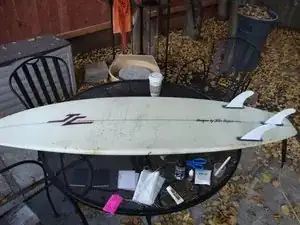
Patching Surfboard Fiberglass
Surfboards have been around for anywhere from 800-4000 years in some form in ancient Tahitian and Hawaiian cultures. Early boards were finless planks constructed entirely from solid wood, sometimes without much consideration of shape or form. Elites rode carefully crafted boards up to 20ft long, which were essentially stand-up paddle boards. Other boards for more common folk still easily exceeded 10ft, some nearly double the length of what we would consider a "longboard" today. Evolutions in board shape through the 1900's introduced hollow construction, rounded rails, the introduction of fins, and rocker.
A surfboard is what you make it, in the sense that you can technically surf a door, a coffee table, a window, a guitar case, and any other assortment of household items. However, a surfboard built for surfing is usually a thin oblong plank of wood, foam, or fiberglass ranging anywhere from 4 to 14 feet in length. Some (but not all) surfboards will include fins, or slots to insert fins, on the back end of the "bottom" of the board, which is shaped to support planing on the water's surface. Shorter boards tend to feature points at the front of the board, while longer boards more typically have rounded front ends. Beyond that, and sometimes in exception of, surfboards come in a wide variety of shapes, sizes, and fin configurations to support a plethora of surfing styles, wave types, and rider preferences.
Most modern surfboards are made out of a polyurethane or polystyrene foam blank with a wooden or carbon fiber "stringer" running through the middle to provide strength. The foam is shaped, then covered with fiberglass cloth and coated with polyester or epoxy resin to provide a hard "glassy" exterior and waterproofing. There are also boards which incorporate wood elements, biodegradable foams and resins, and external foam layers to create a soft top.
It's extremely important to stay on top of repairing cracks and dings for any foam core surfboards, as water ingress can deteriorate both polyurethane and polystyrene boards quickly, leading to delamination, waterlogging, and structural weakness in the board—all of which can negatively affect the way it rides.
One of the most important questions when approaching a surfboard repair is what type of resin was used in its creation. Because the chemical compositions of these resins vary, repairing a board with a mismatched resin type can result in a subpar bond or even damage to the board, so you'll want to ensure that the resin you use for your repair matches the one used to construct your board.
Polyester resin will melt polystyrene (EPS) foam, which is used as the inner material of some epoxy boards. Essentially, if you aren't sure which resin your board is made with, you should opt for epoxy resin to make repairs, as while epoxy won't bond as well to polyester resin, it at least won't do damage.
The next thing to consider is how long-lasting you need your repair to be or, alternatively, how much damage you need to fix. There are several 'one-tube' sun-cure options that consist of a gel that you squeeze out and spread over a ding (note: these are also specific to epoxy and poly applications—get the one that's right for you). Given enough time and UV exposure, it hardens to create a watertight seal over small dings, but is prone to failure over time.
Alternatively, you can get a repair kit for poly or epoxy boards that includes everything you need to lay and glass fresh fiberglass to cover a larger ding. This is quite a bit more difficult and messier, but if done properly will provide a strong, durable repair that will outlast the board.
Lastly, you can take your board to a repair specialist, who will use their refined experience to fill and glass even the largest of dings, the most severe buckles, and in some cases even stitch a board in pieces back together—using much of the same materials you can find in those ding repair kits. This will be the most costly option but will most likely return your board back to showroom condition (at least functionally).
Whether you choose to go the fast-fix sun-cure route or the more long-lasting fiberglass route, the best thing to do is to fix your board so you can ride it again. Take into account the time and effort you have to spend, consider the size and intensity of the damage you need to tackle, and fix your board so you can get back in the water.